Long depressing rainy season has finally ended and summer has started. Summer in Kumamoto is very hot and humid, which is one reason that people describe Kumamoto as “火の国(Hi no kuni, literally means Country of Fire)”.
In the last two articles, I introduced about おてもやん(Otemoyan) which is the most famous folk song in Kumamoto and places which have relationship to it.
Today, I’m going to share another 聖地巡礼(Seichi Junrei, pilgrimage) spot, which is 北岡神社(Kitaoka Shrine) in 熊本市(Kumamoto City).
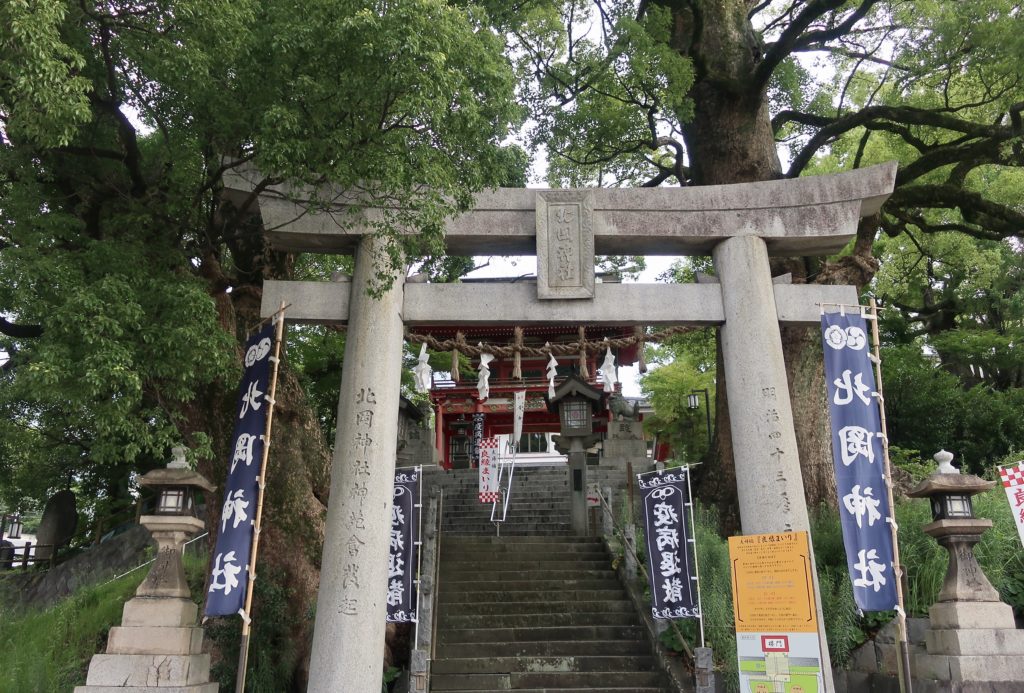
Kitaoka Shrine has an over-1,000-year of history and one of the oldest shrines in Kumamoto City. It takes about 10 minutes on foot from Kumamoto Station and there is a tram station nearby. I know it is difficult now but hopefully in the near future when you visit Kumamoto next time, you will include Kitaoka Shrine into your itinerary. So let’s see what we can enjoy there!
Contents
- 1 Kitaoka Shrine(北岡神社) in Kumamoto City(熊本市)
- 1.1 History of Kitaoka Shrine(北岡神社)
- 1.2 Husband and Wife Camphor (夫婦楠) which is believed to bring you good luck for match-making.
- 1.3 Tower Gate(楼門) ~the Entrance of Sacred Place~
- 1.4 Which deities are enshrined at Kitaoka Shrine(北岡神社)? ~Another Story of Susanoo who made the Sun Goddess furious~
- 1.5 Tour in the ground of Kitaoka Shrine(北岡神社)
- 1.6 Otemoyan(おてもやん) and Kitaoka Shrine(北岡神社)
- 1.7 Visit Kitaoka Shrine(北岡神社)!
- 1.8 Map
- 1.9 共有:
Kitaoka Shrine(北岡神社) in Kumamoto City(熊本市)
History of Kitaoka Shrine(北岡神社)
Kitaoka Shrine stands in 春日(Kasuga) which is in Nishi-ku, Kumamoto City. It was established in 934 and one of the oldest shrines in Kumamoto City. At that time, the shrine was in 二本木(Nihongi, also in Nishi-ku, Kumamoto City). It is said that the founder came from Kyoto and he invited a deity from the famous Gion Shrine there. That is why Kitaoka Shrine was called 祇園社(Gion-sha, Gion Shrine) at that time. In 979, it was transferred to 朝日山(Mt. Asahi) which is now called 花岡山(Mt. Hanaoka), Nishi-ku, Kumamoto City.
After 500 years later, it was the chaotic era called 戦国時代(the Age of Civil Wars). The shrine had flourished but ended up to lost its power by being taken away shrine territory. In 16th century, 加藤清正(Kiyomasa Kato) was ordered to govern Kumamoto and worked hard to protect the shrine. Later, when 細川家(Hosokawa Family) started to rule Kumamoto, they continued protecting it for generations. In the middle of 17th century, the shrine was transferred to the place where the shrine stands now. In the late 19th century, they renamed it as 北岡神社(Kitaoka Shrine).

Source : 北岡神社
The nearest tram station is 祇園橋(Gion-bashi, Gion bridge). Even though the name has been changed several times, we can see how people value their history’s importance and try to preserve it.
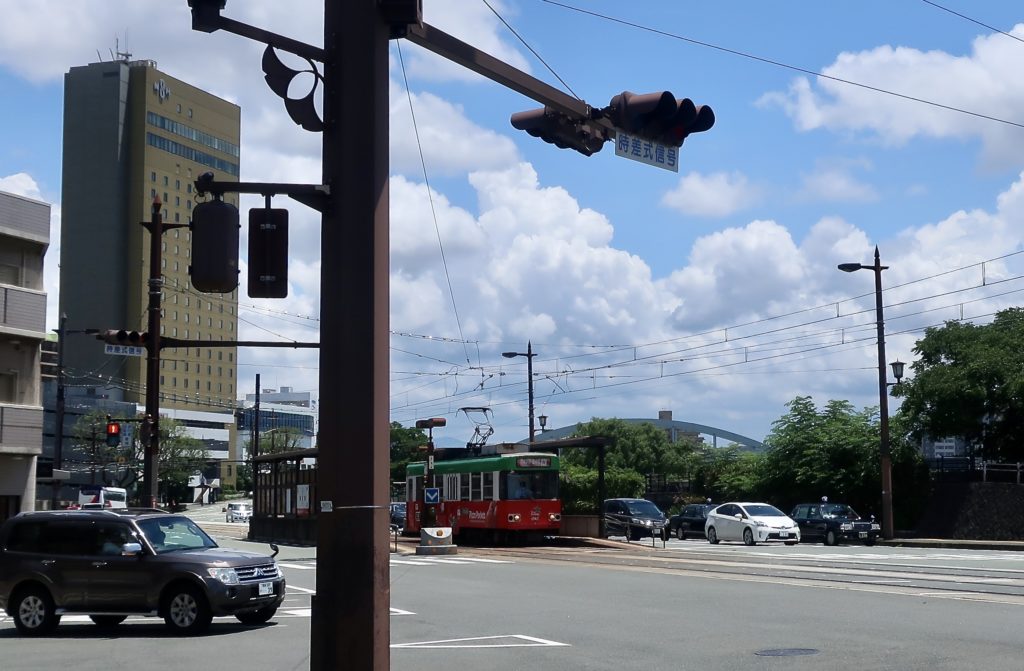
※ When I looked back the last articles, such as 釈迦院(Shaka-in Temple) and 六殿神社(Rokuden Shrine), I found out that how well Kiyomasa Kato protected shrines and temples and how Hosokawa Family continued to support them.
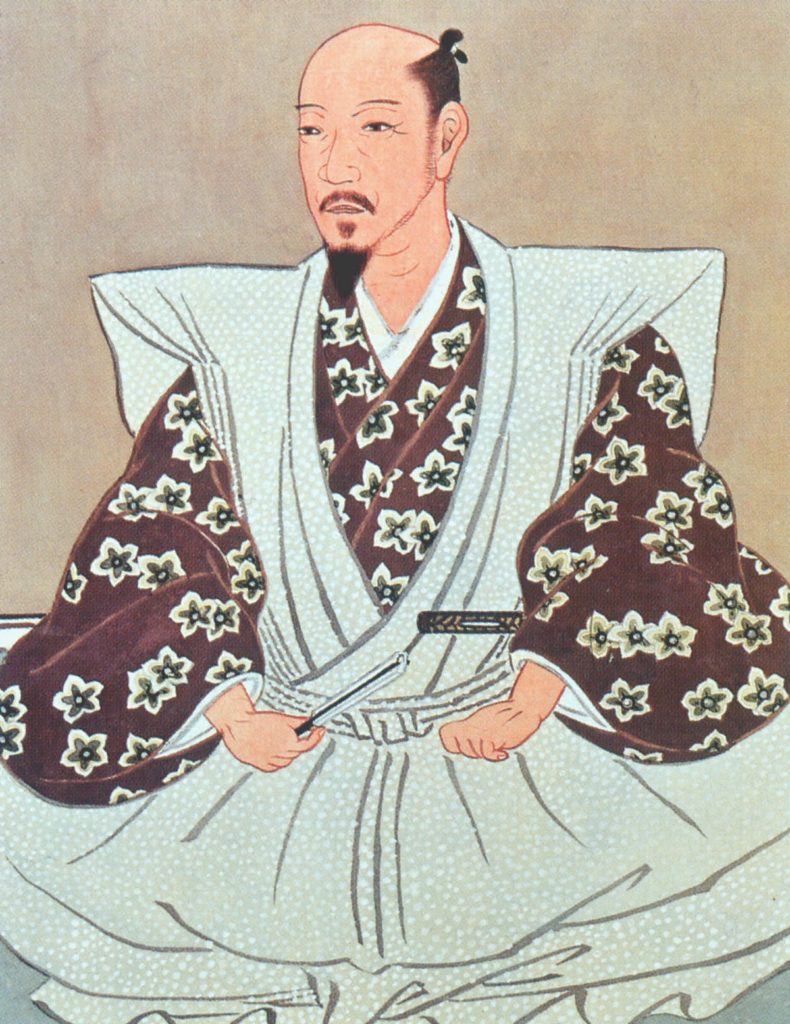
Source : Wikipedia
When Kato came to Kumamoto, it was desolated after many battles. He is famous for building Kumamoto Castle and working on river improvement and irrigation but at the same time, he worked hard to rebuild and protect shrines and temples. Kato knew they were quite important for local people. Because of his great works, Kato has been the most popular historical character in Kumamoto.
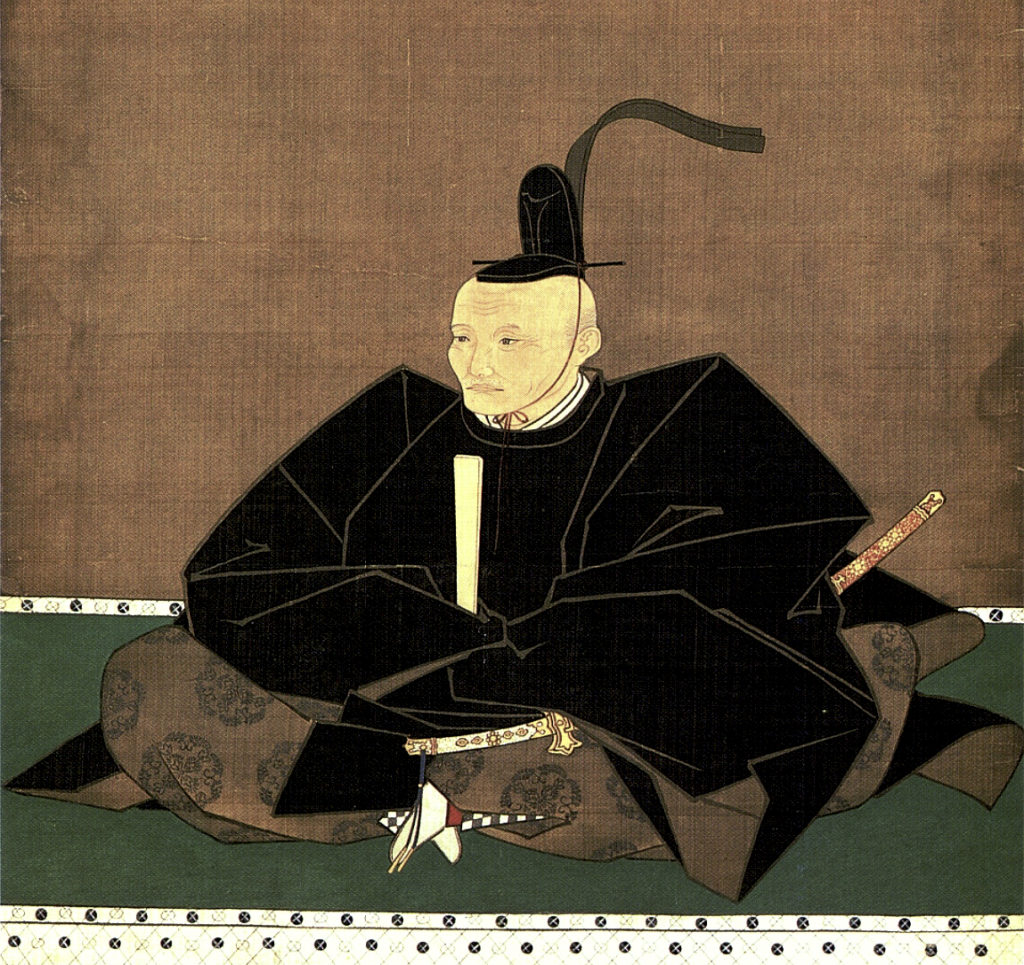
Source : Wikipedia
After Kato’s son was exiled, Kato’s era ended and Hosokawa Family was ordered to rule Kumamoto. At that time, Kumamoto was infamous for the frequent riots. When the first Lord of Kumamoto, 細川忠利(Tadatoshi Hosokawa) came to Kumamoto, he climbed up Kumamoto Castle and prayed towards 本妙寺(Honmyo-ji Temple), where Kiyomasa Kato is enshrined, promising he would take good care of Kato’s people and territory. People loved Hosokawa’s respectful behavior. It made the family popular and easier to rule Kumamoto after 400 years. Both Kato and Hosokawa Families worked hard for people and try to harmonize with them to make a better country together.
Husband and Wife Camphor (夫婦楠) which is believed to bring you good luck for match-making.
So, now let’s explore in 北岡神社(Kitaoka Shrine).
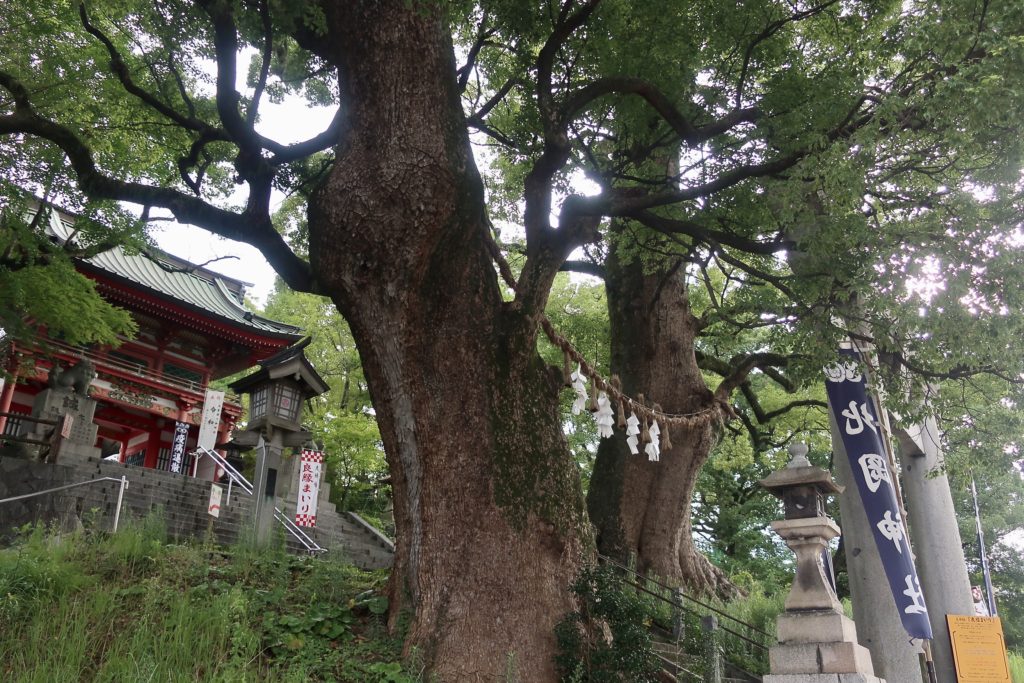
When you arrive there, the first thing catches your eyes must be these huge 楠(Kusunoki, camphor). The two camphors stand on both side of 鳥居(Torii gate). They are called “夫婦楠(Meoto kusunoki)”, means Husband and Wife camphor. Do you remember “夫婦滝(Meoto waterfall)” in 南小国町(Minamioguni town)? When people see something like pairs, we love to name them “husband and wife”.
It is said that the camphors are more than 1,000 years old so when Kitaoka Shrine was transferred to the present place, they were already there and people built Torii gate in the middle of the trees.The right one is called “雄楠(Ogusu, male camphor)” and 21m high and 12 m of diameter. The left one is called “雌楠(Megusu, female camphor)” and 25m high and 10.3 m of diameter.

Around the camphors, you will see some boards saying “良縁まいり(Ryoen-mairi)”, means making a wish for match-making. It is said that if you walk around the husband and wife camphor with 8 shape horizontal eight, like this → ∞), then you will get good luck for encountering with good relationship, friends, business, health, education, etc. So basically, you will get good luck for everything!
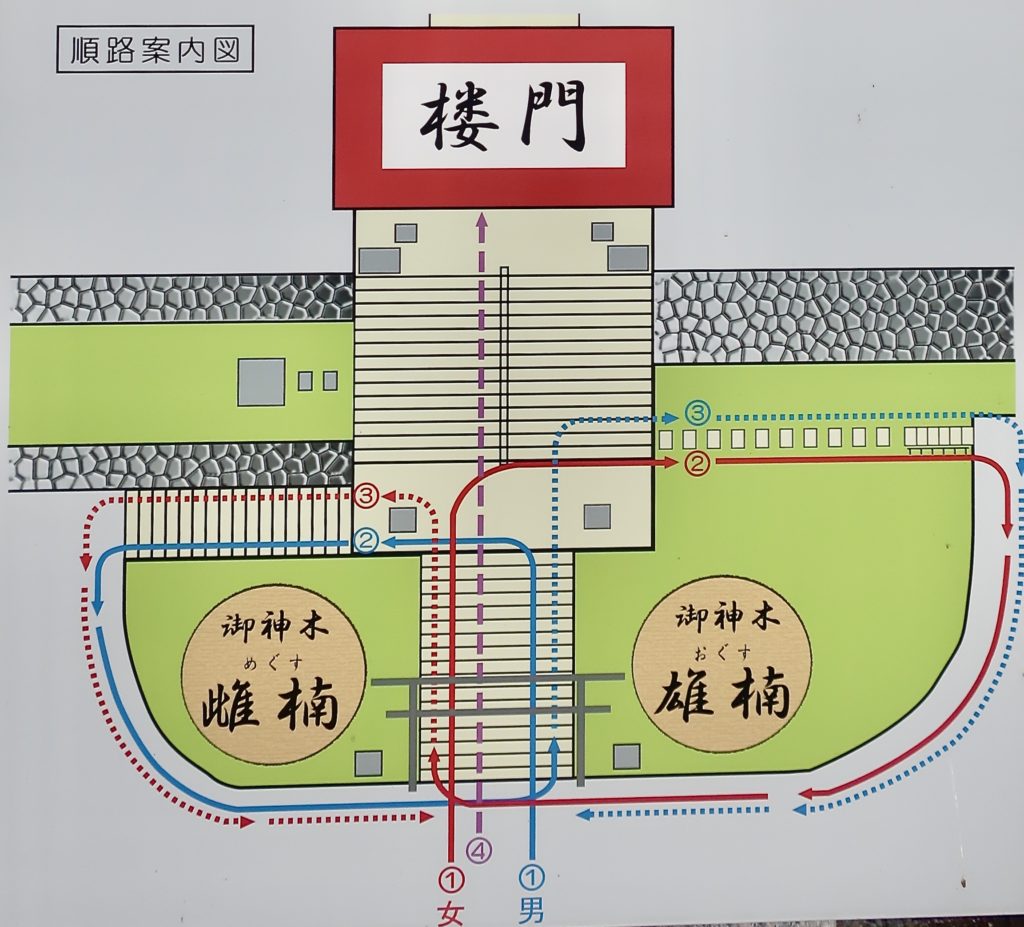
So, let’s try together. This board explains the order to walk around. From Torii gate, climb the stone steps until the flat space in the middle. If you are a woman, you will turn right, go down the stairs and come back to the starting point.
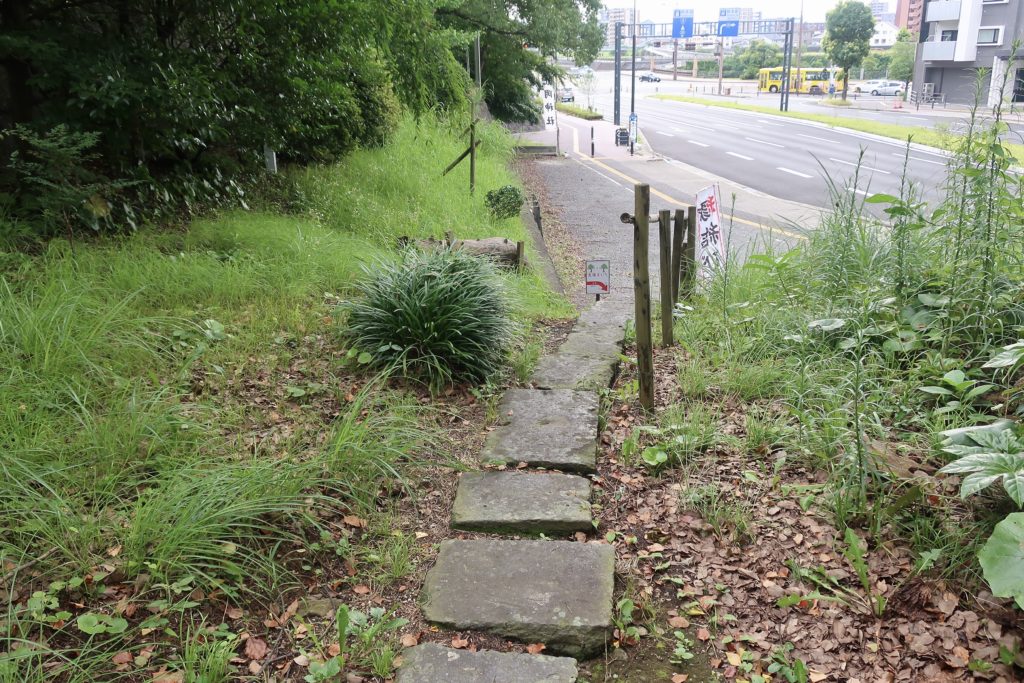
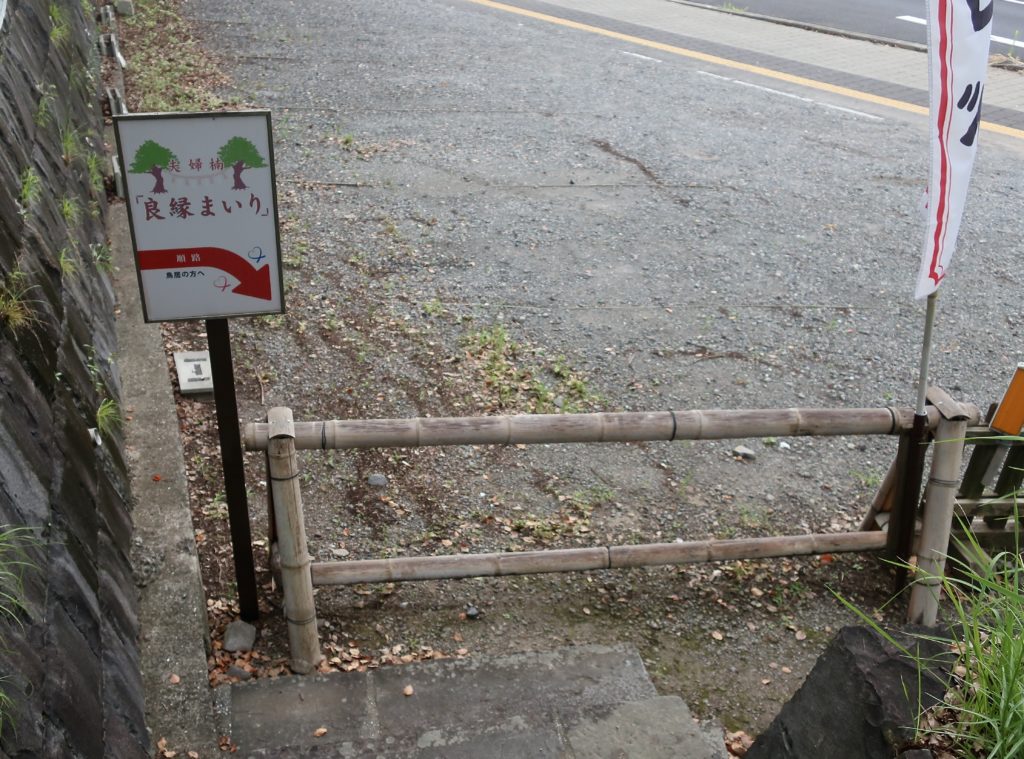
Next, turn left, go down stairs and come back to Torii gate.
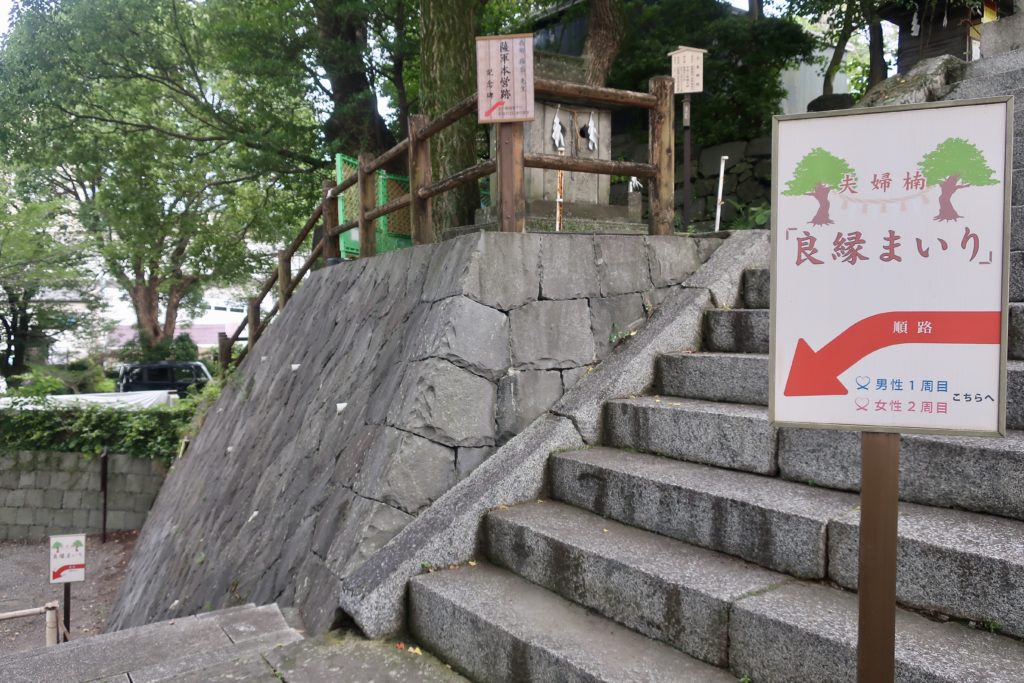
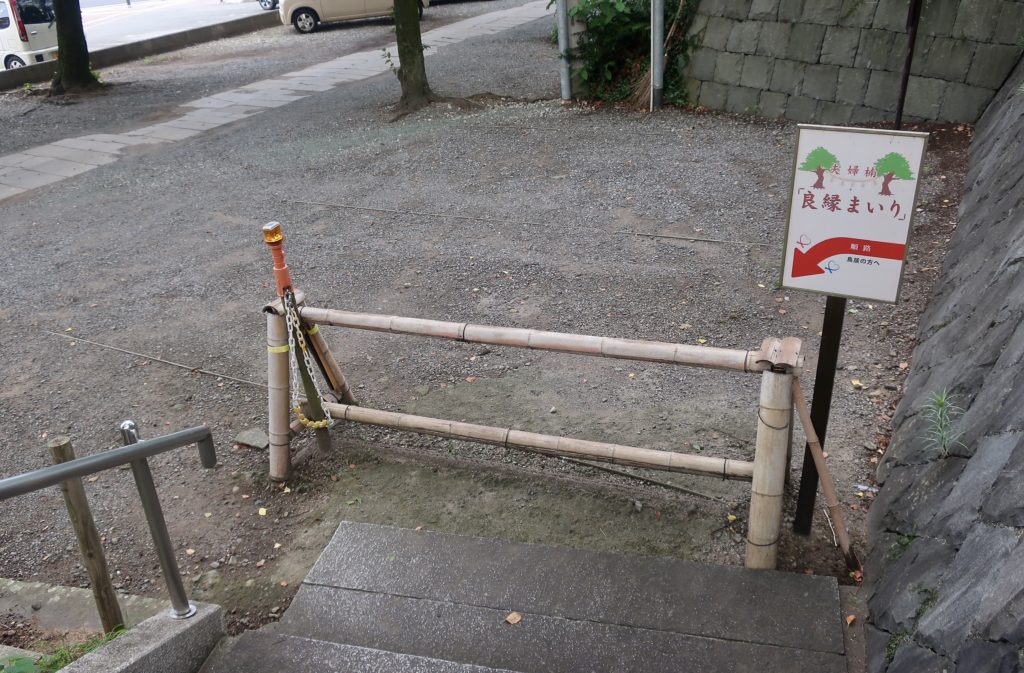
Bow once in front of the gate and you can go forward to the main hall.
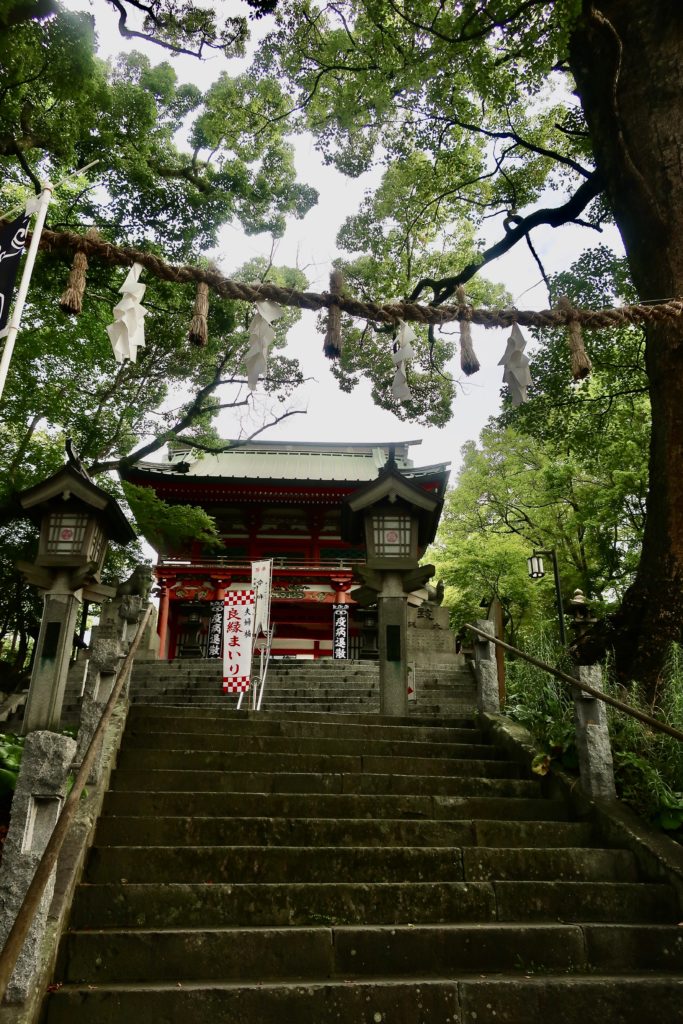
If you are a man, you go vise versa. Easy, isn’t it? Try it when you visit there!
Tower Gate(楼門) ~the Entrance of Sacred Place~
At the entrance of Kitaoka Shrine, this vivid red 楼門(Romon, Tower gate) will also attract you.
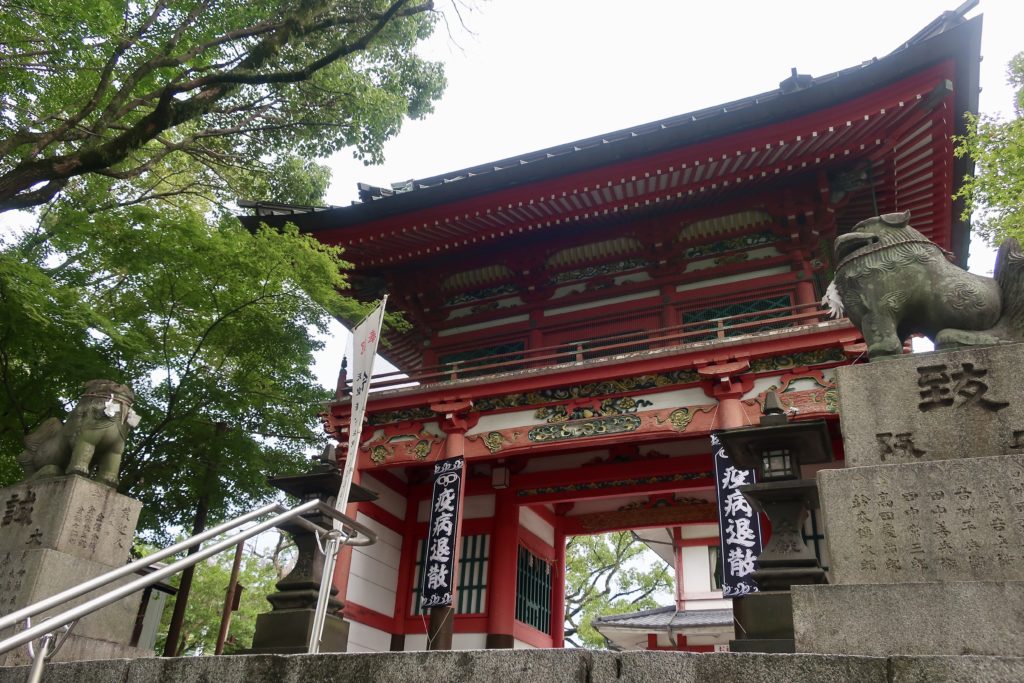
As I explained in the article about 六殿神社(Rokuden Shrine), Tower gate is something that separates from the world of gods and the world of human. So basically, tower gate and Torii gate work the same. I heard that tower gates started to be built because of the affect by Buddhism. Also it is said that people in power donated to shrines building a gorgeous tower gate so that they can show off their power. I couldn’t find when this Romon gate was built but I can see it existed in the middle of 19th century by the picture after it was transferred to the present place.
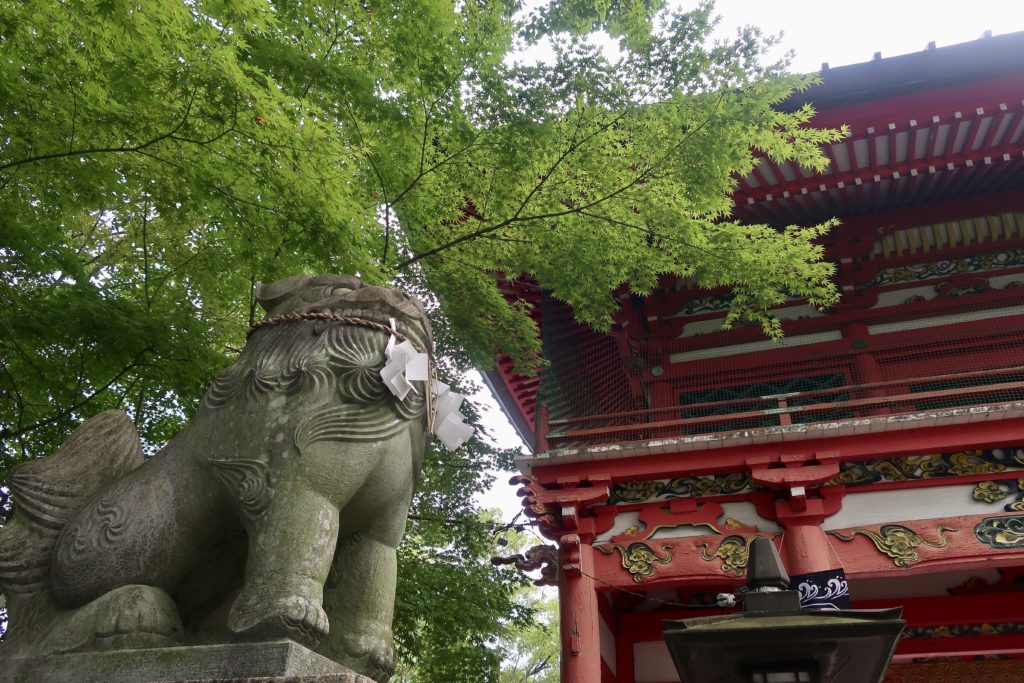
⬇️Get to know more about 楼門(Romon) gate in the previous article below!
Which deities are enshrined at Kitaoka Shrine(北岡神社)? ~Another Story of Susanoo who made the Sun Goddess furious~
As walking towards the worship hall, I found this board near to the building where we can purchase lucky charms.
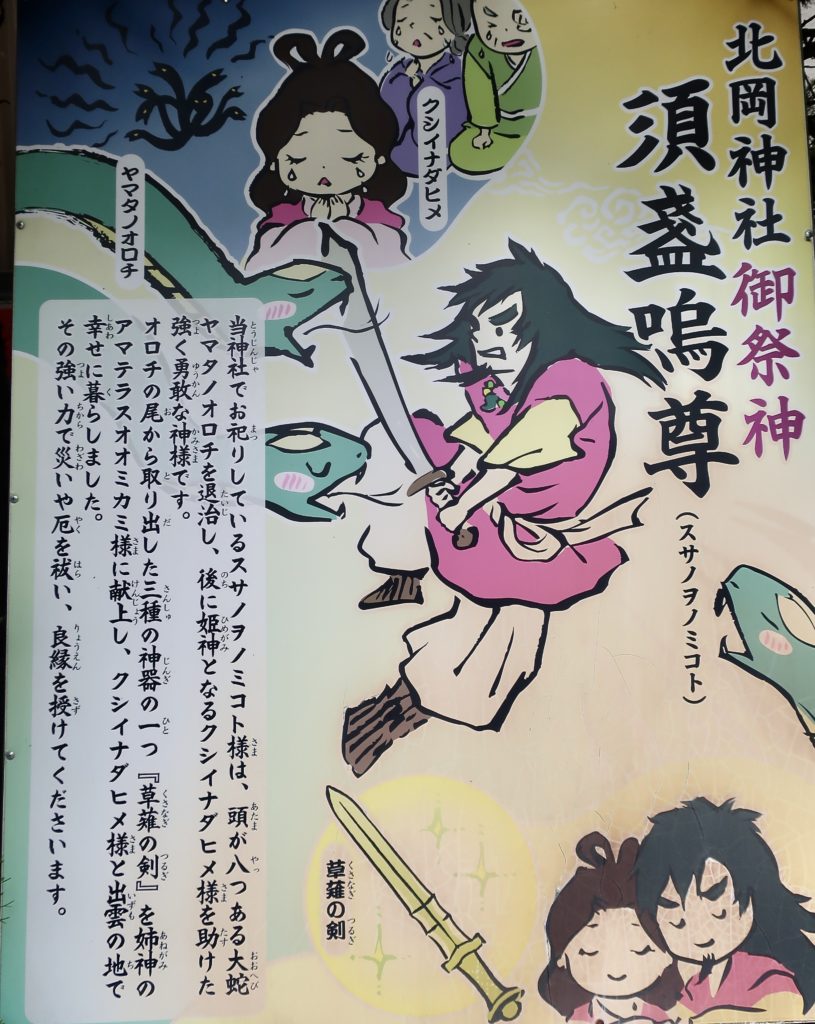
On this board, we can see pictures of deities, 須佐之男命(Susanoo) and his wife 櫛稲田姫(Kushinada-hime), that Kitaoka Shrine enshrines.
Do you remember “Susanoo”? Susanoo is one of the famous deities in Japanese mythology. He is a brother of 天照大神(Amaterasu Omikami, Sun Goddess). Susanoo behaves very bad and messed things around so Sun Goddess got furious and hid in a rock cave so the world had lost light completely. This is a part of the story of the famous “天の岩戸(Ama-no-iwato, the rock cave)”.
⬇️ Get to know the story of “天の岩戸(Ama-no-iwato, the rock cave)” more!
There is an after-story.
After Susanoo was exiled from the world of gods, he was roamed around from place to place and one day he reached to a place called 出雲国(Izumo-kuni) which is now 鳥取県(Tottori Prefecture). He was standing near a river and saw chopsticks running flowing from up the river. He thought there should be someone so walked towards it. When he went up to the river, he found that there were an old couple and their young daughter, named 櫛稲田姫(Kushinada-hime) and they all were crying. They told Susanoo that they used to have eight daughters but every year 八岐大蛇(Yamata no Orochi, enormous snake with eight heads) came and ate one by one. That year would be the eighth year and he would come here soon and eat their last daughter.
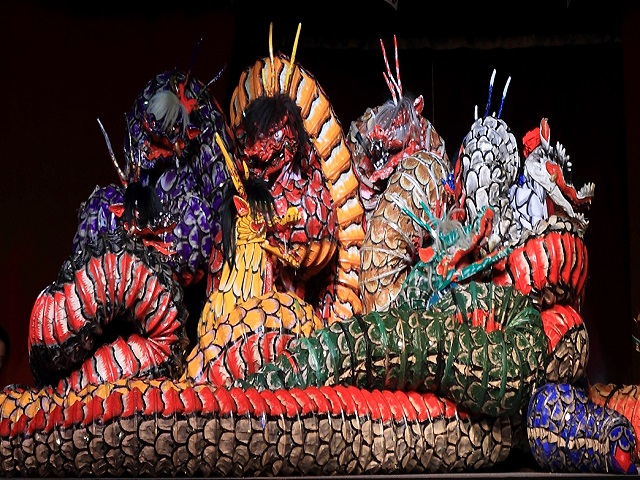
Source : 霧島市観光協会
Susanoo felt very sorry for them so he offered himself to defeat the monster. He also asked the couple if Susanoo could beat Yamata no Orochi, he would like to marry their daughter. At first, they got confused because they didn’t know anything about this stranger but after Susanoo revealed that he was a brother of Sun Goddess, they appreciated it and accepted his offer. When everyone was ready for a big fight, Susanoo changed Kushinada-hime into a comb and he put it to his hair.
※ You may wonder why Susanoo changed Kushinada-hime into a comb. It is said that people in the past believed combs have magical power. Susanoo wanted to protect Kushinada-hime so he changed her into comb and tried to protect her. It is also said that Susanoo wanted to use the magical power to beat Yamata no Orochi so he put the comb and got power from it.
First, Susanoo prepared eight bins of strong spirit which was distilled eight times(must be very pure and strong!). After a while, Yamata no Orochi appeared and looked for Kushinada-hime. Then, this monster smelled something very nice. He found the liquor and each head dived into each bin.
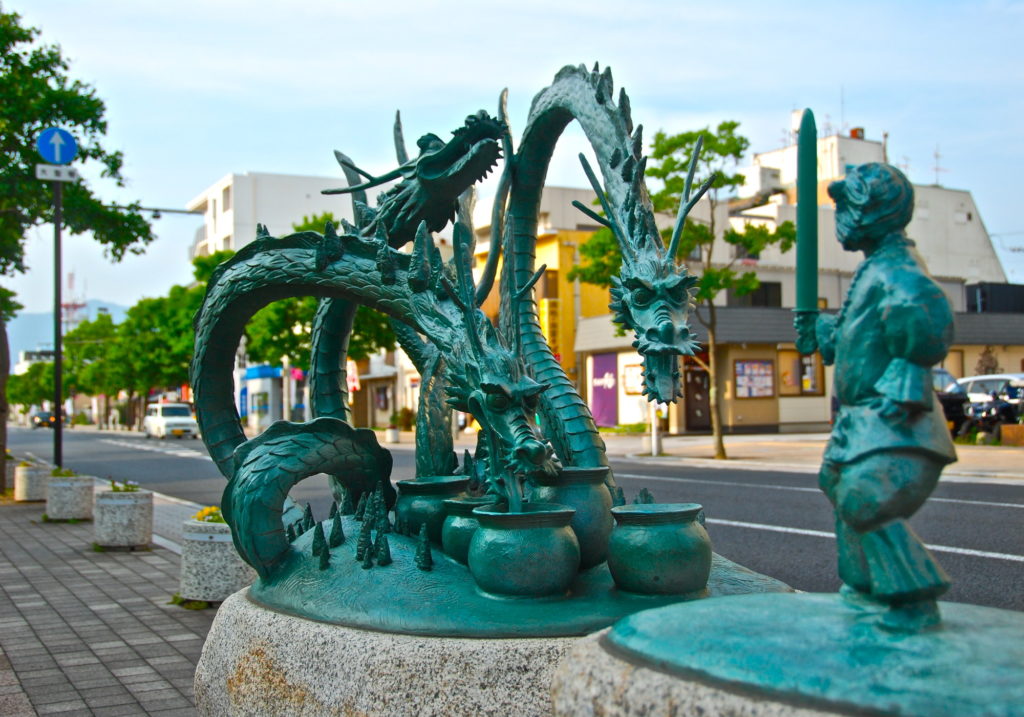
Source : https://www.kokugakuin.ac.jp/article/150943
Because it was very strong, Yamata no Orochi got intoxicated pretty quickly and ended up to fall asleep. Everything went very well as Susanoo planned. He slashed at each head and the body. At the last slash at the monster’s tail, the sward was chipped. Susanoo noticed that there was something in its tail. He looked closer and found a beautiful sword which is later called as “天叢雲剣(Amenomura kumo no tsurugi)” and this is now one of the three Sacred Treasures symbolizing the Japanese Imperial throne : the mirror, the crescent jewel and this sword. Susanoo became a hero after defeating Yamata no Orochi and got married to Kushinada-hime.
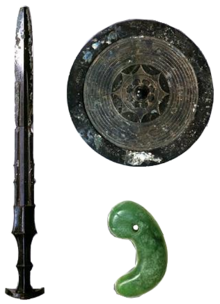
Source : Wikipedia
At first, deities and people hated Susanoo because of his horrible behaviors but after sacrificing himself to fight for the monster, he became a hero. Actually, Susanoo is one of the popular deities in Japanese mythology. I introduced some stories of our mythology here so check it and tell me which deity you like the most!
⬇️ About Izanagi and Izanami who are believed to create Japan.
⬇️ One of the famous story, Ama-no-Iwato(Rock Cave) that you will learn how naughty Susanoo was!
Tour in the ground of Kitaoka Shrine(北岡神社)
After passing the board of Susanoo, climb the stairs then you will arrive at the main area. I visited there in the early morning and there were only a couple and me. Enjoy walking around the premise and I hope you will find something interesting!
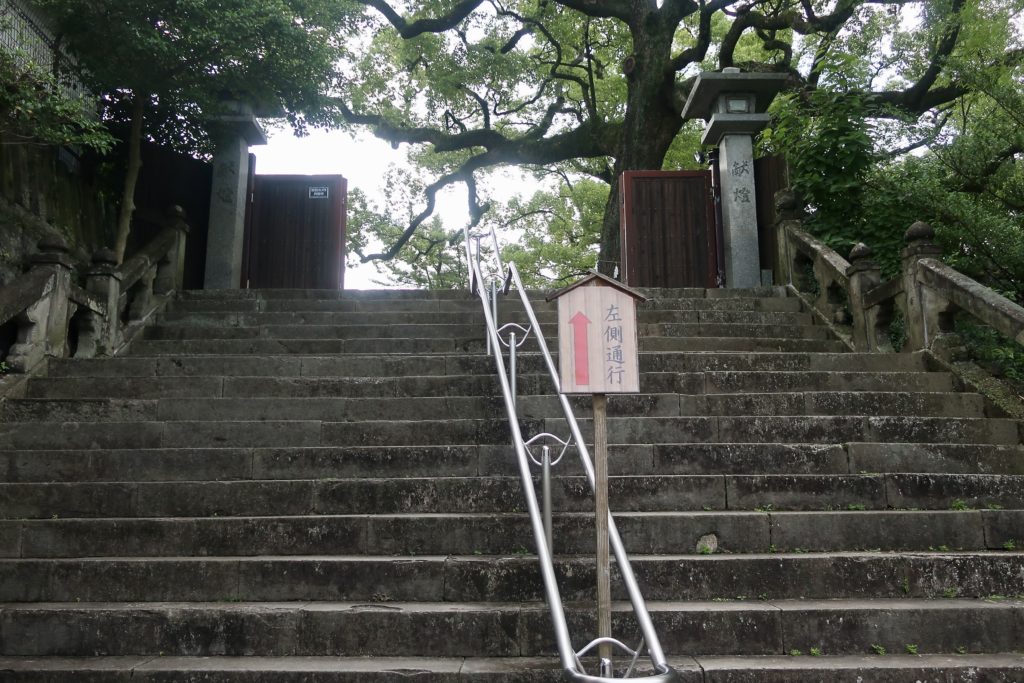
Huge Camphor trees ~Do you know why we have many camphors in shrines?~
When you arrive at this area, these huge camphor trees will welcome you.
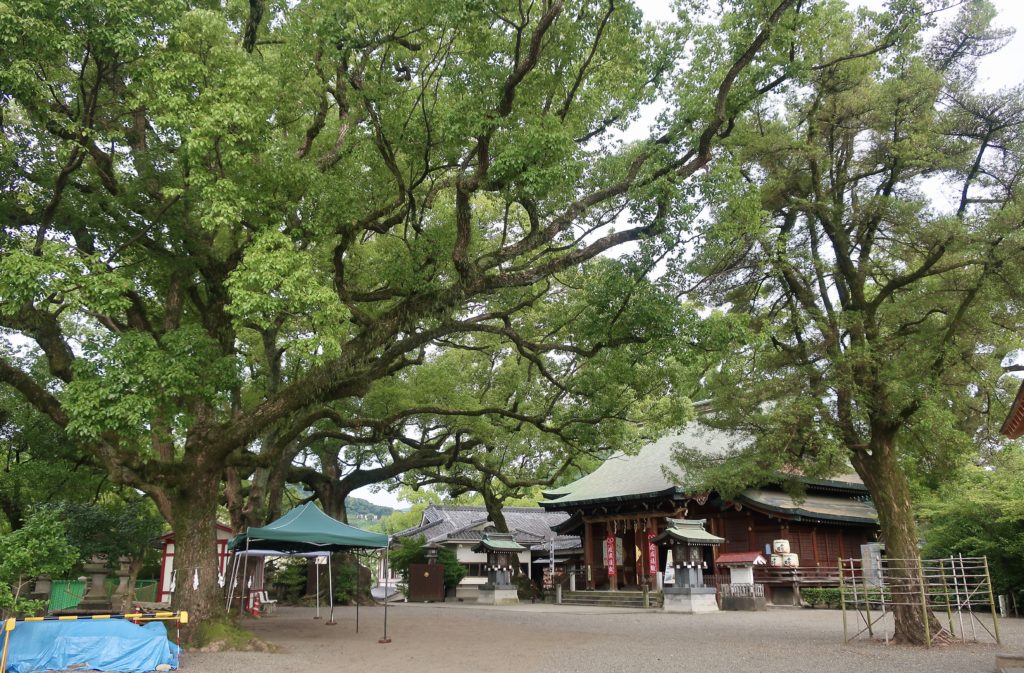
This one is called 宝授の大楠(Houju no Okusu), literally means a huge camphor which will bring fortune. Fortune means not only money but also babies. Kitaoka Shrine is also famous for bringing luck to get pregnant. Couples visit there and rub the trees which looks like a pregnant woman’s belly.
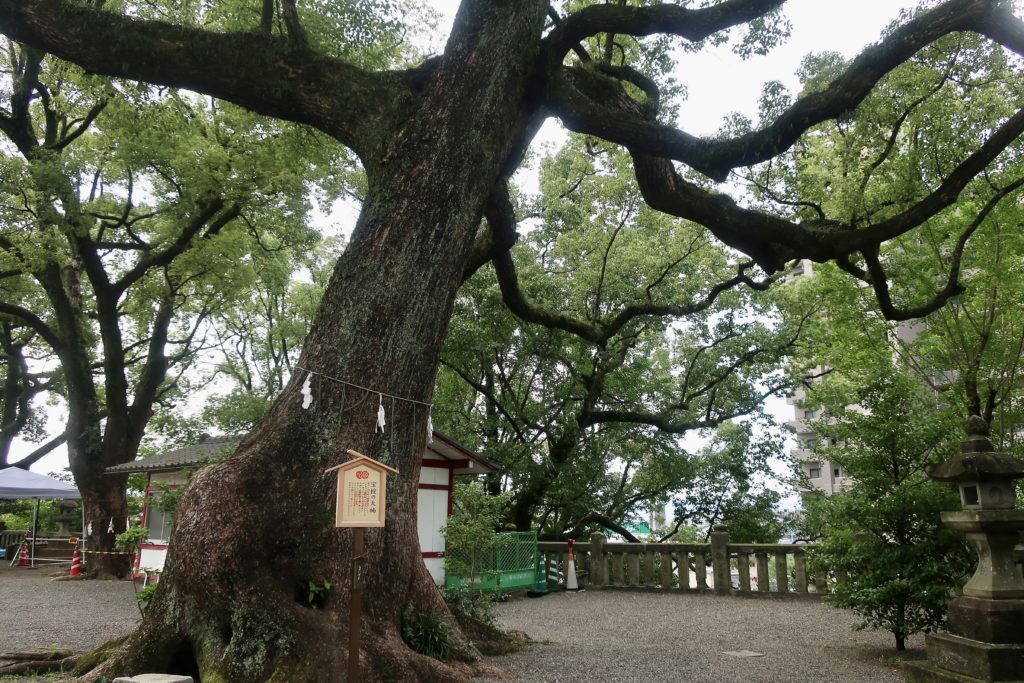
I introduced several shrines and saw many big camphor trees there. Do you know how shrines and camphors are related? I checked and found mainly two reasons. First, camphor trees are evergreen and get taller so people describe them as a symbol of life. They also work as a windbreak to protect shrines. Second, we can get the chemical substance, “camphor” which is used for making antiseptics and ointment. In Japanese, we call “くすり(kusuri)” for medicine and “楠(kusunoki)” for camphor. At first, people called camphors as “trees of medicine(Kusuri-no-ki)” so some say the sound gradually changed and became “kusunoki”.
Worship Hall(拝殿) ~Learn how to make a wish at shrines!~
This is the worship hall and was built in 1934.
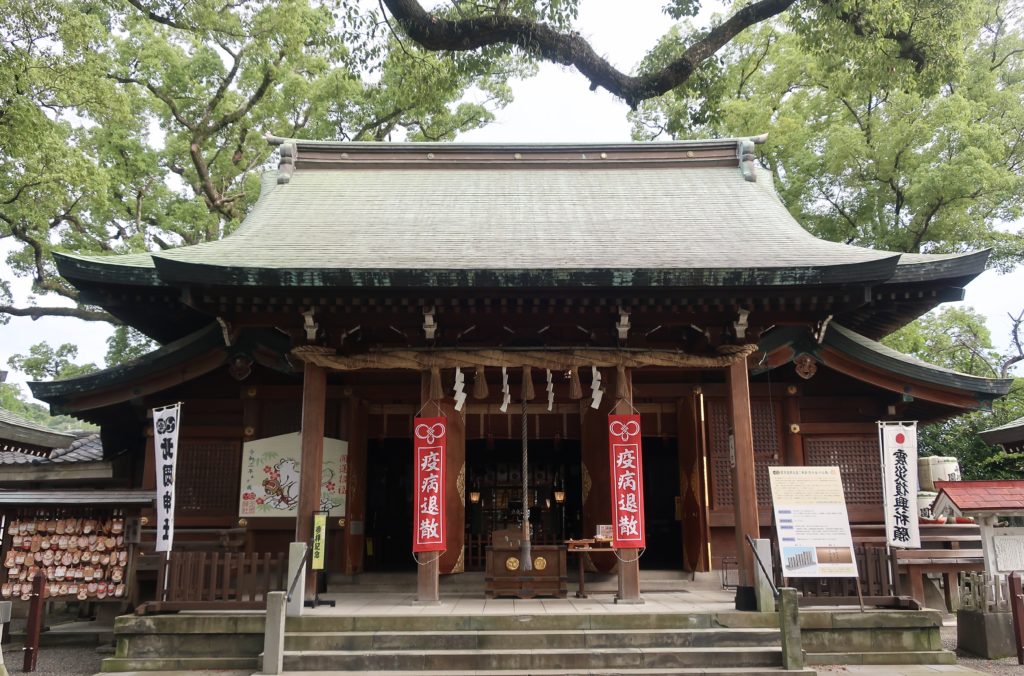
You may have visited some shrines before but do you know how to make a wish there? On 賽銭箱(Saisen-bako, a wooden box which you throw money into), I found this explanation how to do it. I added some extra information so let’s see it.
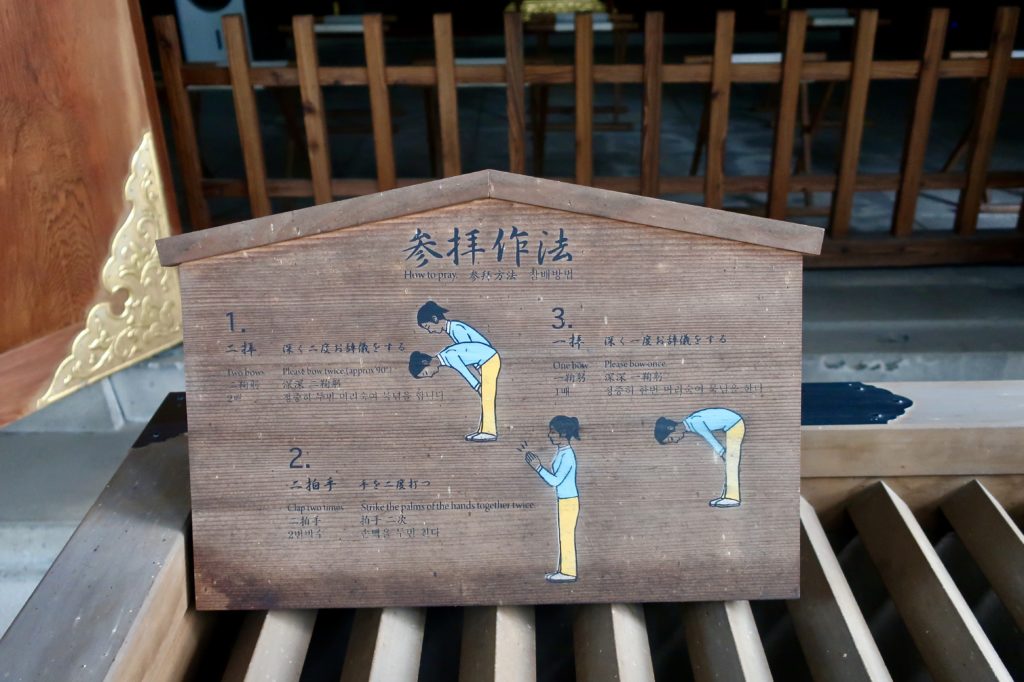
- Throw a coin to a wooden box and ring a bell.
- Bow twice to respect deities(It says bow approximately 90 degrees!).
- Clap your hands twice to attract deities’ attention.
- Make a wish silently. (It is said that it’s better to say your name and your address at first so that deities can easily detect you and it makes them easier to make our wish come true!)
- Bow once to appreciate them to listen to us.
It is a little embarrassed to share with you but I, even as a Japanese, sometimes forget the order. But, I found how to remember it.
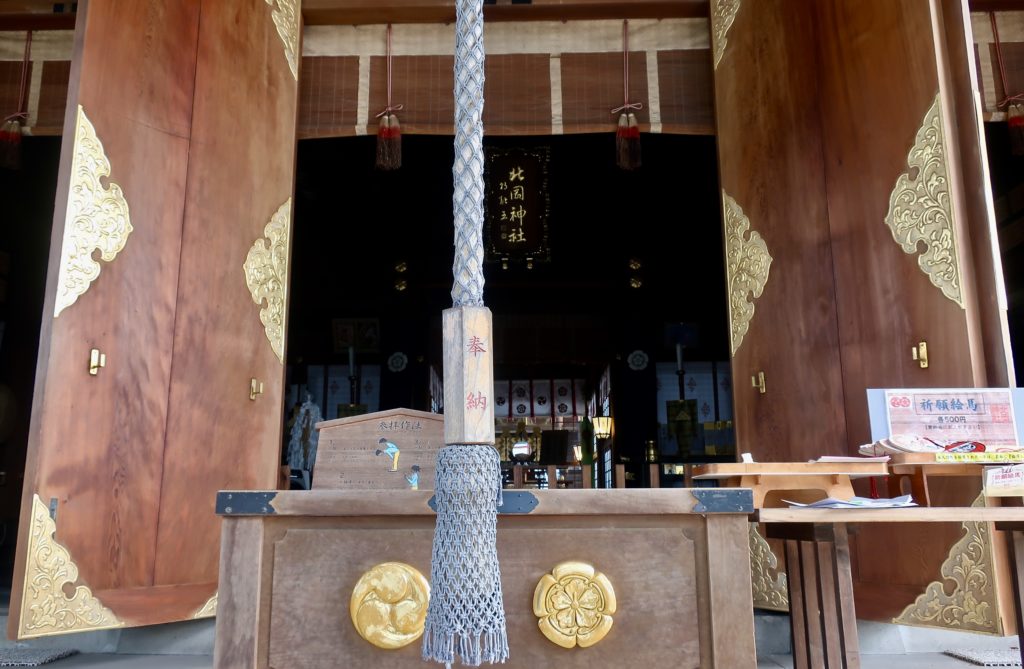
If you have experience of any martial arts, you may have heard this maxim, “例に始まり例に終わる。(Rei ni hajimari Rei ni owaru.)” which means beginning and ending with a bow of respect). Martial arts, such as Karate, Ju-do, Ken-do, value 礼儀(Reigi, courtesy). When players enter a venue, they bow to respect it and when they face their opponent, they bow to respect them. Once it’s finished, no matter they win or lose, they again bow to appreciate this once-in-a-lifetime opportunity.
At shrines, when you look carefully, you will notice people bowing before passing through Torii gate and when they they leave, they again bow at the gate. This is a spirit of respecting and appreciating others.
I guess I got off track but if you get confused the order of making a wish at shrines, remember “beginning and ending with a bow of respect” and in between, you can clap your hands to draw deities’ attention to you!
Ema(絵馬)
On the left side of the worship hall, you will see this board full of 絵馬(Ema), wooden plates with a picture.
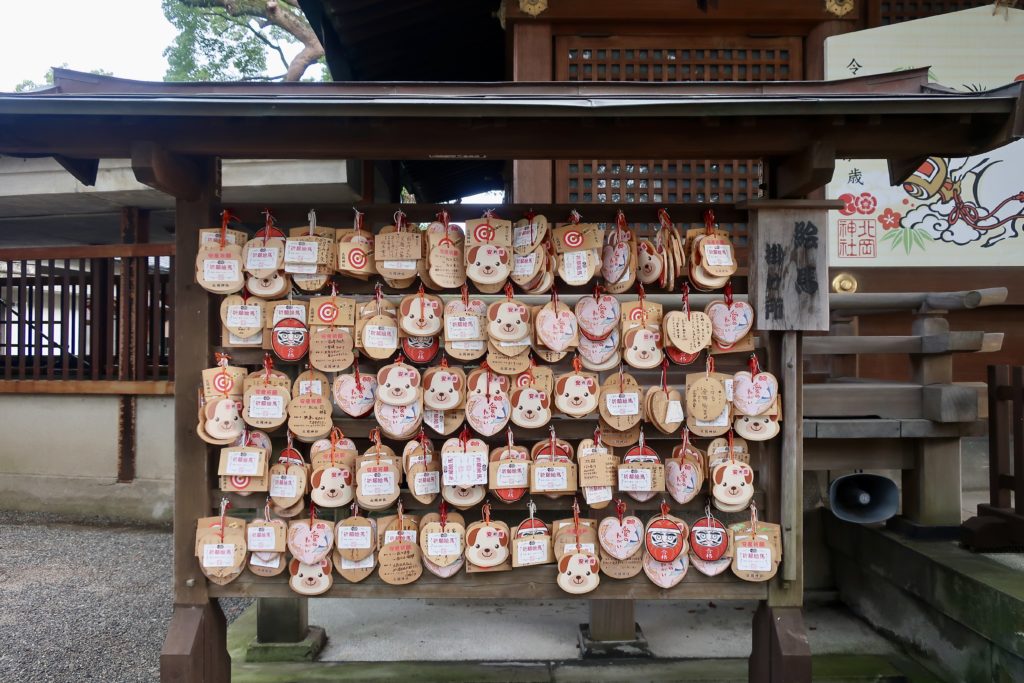
In the past, people used to dedicate a real horse to make their wishes come true. After 室町時代(Muromachi period, 14-16th century), instead of a real horse, a small piece of wood which has a picture of horse on it started to be used. Now, each shrine make their original Ema depending on what lucks they bring.
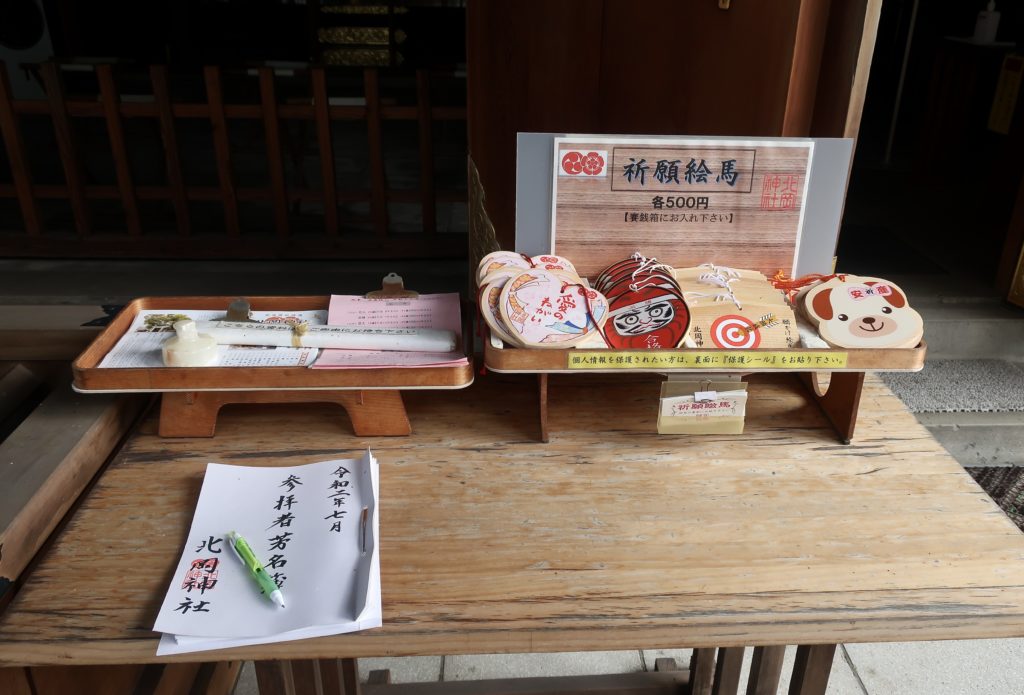
For example at Kitaoka Shrine, they are famous for match-making, safe delivery of a child. So they have a heart-shaped one for good match-making, baby bear for safe delivery of a child. Also, you can see 達磨(Daruma) which is a scary red face, which is a symbol of good luck and so as the Japanese archery one. It is 500 yen each and you can put money into the wooden box. Usually, people write something personal so if you want, you can attach privacy-protection sticker above your message so that only deities can read it!
Otemoyan(おてもやん) and Kitaoka Shrine(北岡神社)
The opportunity that I visited Kitaoka Shrine was おてもやん(Otemoyan). I have written about the most famous folk song in Kumamoto and explored around the world of its model 登茂(Tomo) and composer イネ(Ine).
⬇️ If you haven’t read the previous article about Otemoyan, I recommend you to read it first!
In 1871, the new Meiji Government enacted a law of Family Registration. They demanded people to go to the nearest shrine and get a 氏子札(Ujiko-fuda plate) to prove their identification.
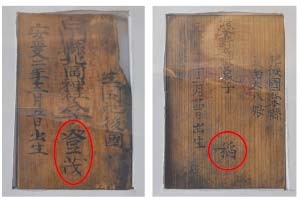
Source : https://kumamoto.tabimook.com/greate/detail/25
When Ine, who was the composer of Otemoyan, passed away, her pupils found Ine’s Ujiko-fuda plate and other two plates. These two turned out to be Tomo’s and Toju’s(Tomo’s sister). It shows that how close Ine and Tomo were and when Tomo passed away, Ine took them over and had kept them with her. Looking closely to these pictures of Ujiko-fuda plates, you will see “北岡神社(Kitaoka Shrine)” in the middle of the plate. When Tomo was small, she and her family lived in Kasuga, that is the area Kitaoka Shrine stands. It presents Tomo visited Kitaoka Shrine frequently and it make me feel more closer to the local historical figure.
Visit Kitaoka Shrine(北岡神社)!
I visited Kitaoka Shrine in the middle of July and saw some flags saying “疫病退散(Yakubyo taisan)”.
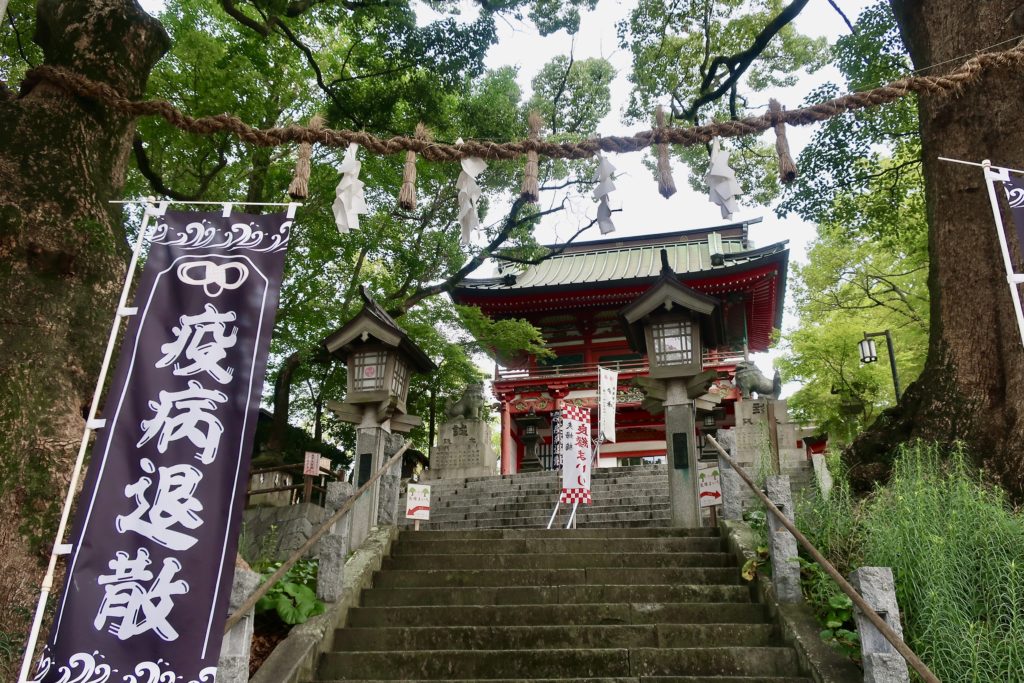
It means warding off plague. After the pandemic of coronavirus, people started to make wishes at shrines or some started to draw アマビエ(Amabie) as a symbol of warding off plague. Amabie is a local Kumamoto “妖怪(Yokai, a Japanese folk monster)” which is believed to predict bountiful harvest and pandemic of plague. To stop a pandemic from happening, Amabie advised people to draw an image of Amabie and show it to others as many people as possible.
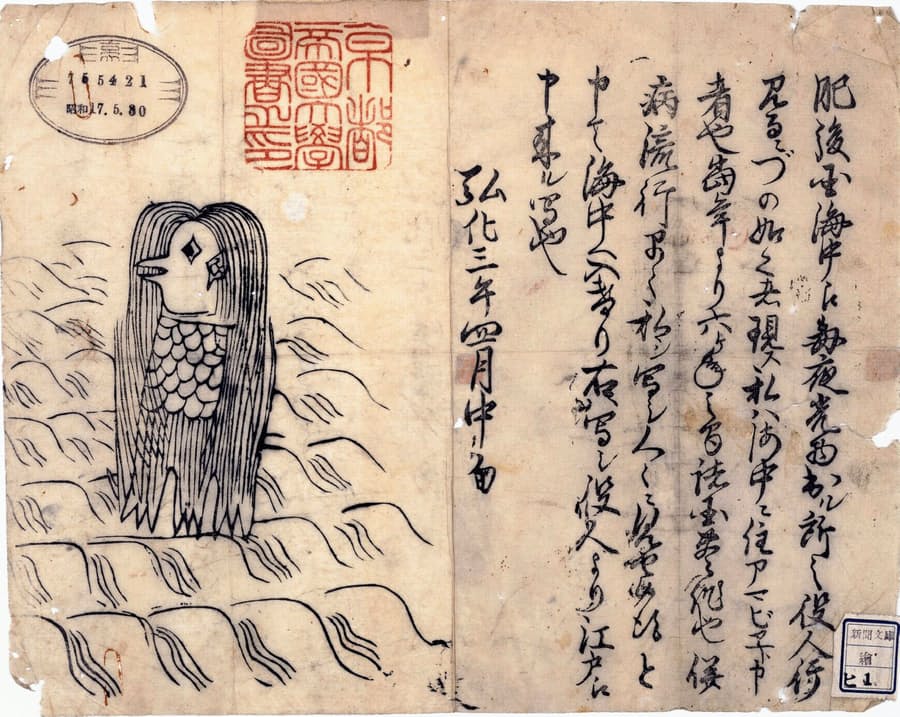
Source : 日本経済新聞
If you want to know more about Amabie, check the article below from BBC!
→ http://www.bbc.com/travel/story/20200422-amabie-the-japanese-monster-going-viral
2020 turned to be a very difficult year for everyone. In Kumamoto, the number of cases of COVID-19 has been increasing rapidly since last month. In July, the southern part of Kumamoto was severely devastated by torrential rain and following floods.
Still, life goes on and we should move forward. It is burning hot outside but visiting shrines(maybe early morning) gives us peace back in our mind. Shrines are open to anyone and if you live in Japan, you will easily come across one. Visit one sometime and just relax there. Please take care and stay safe.
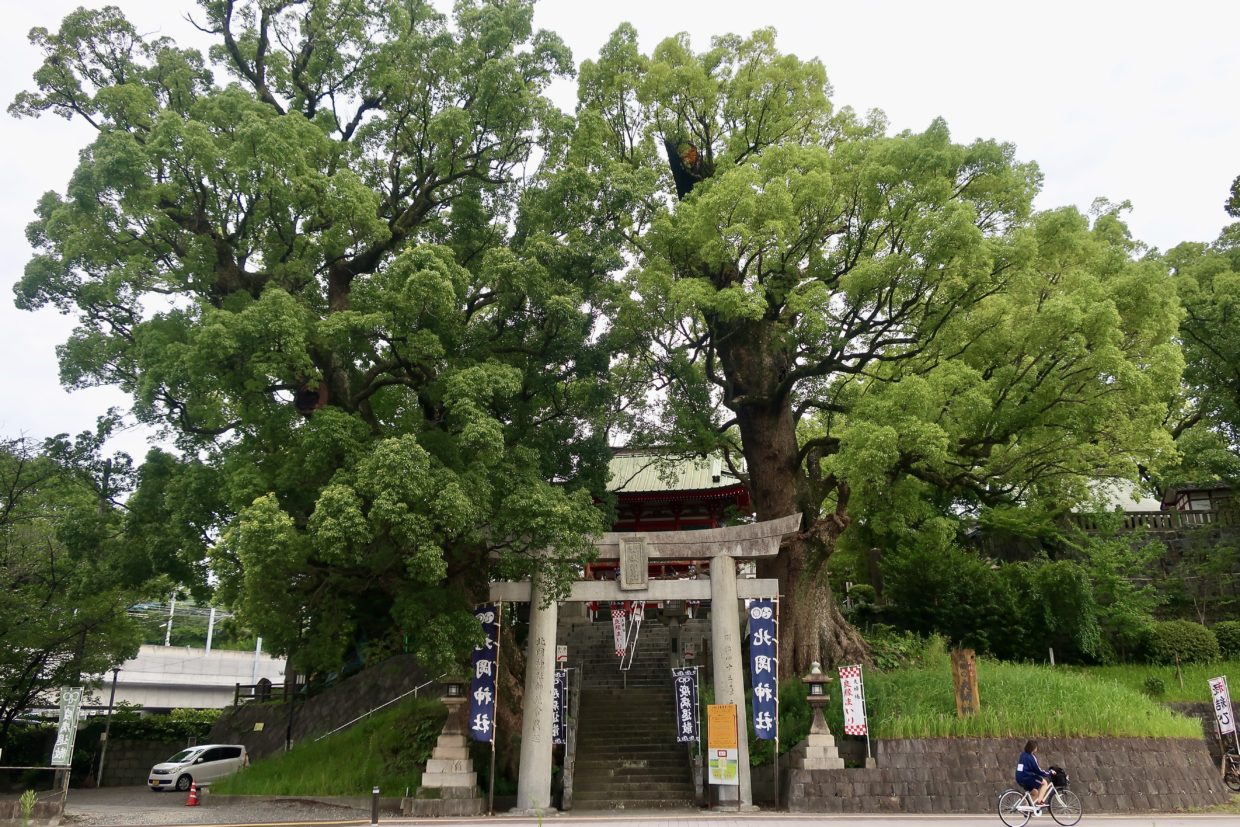
2 ピンバック